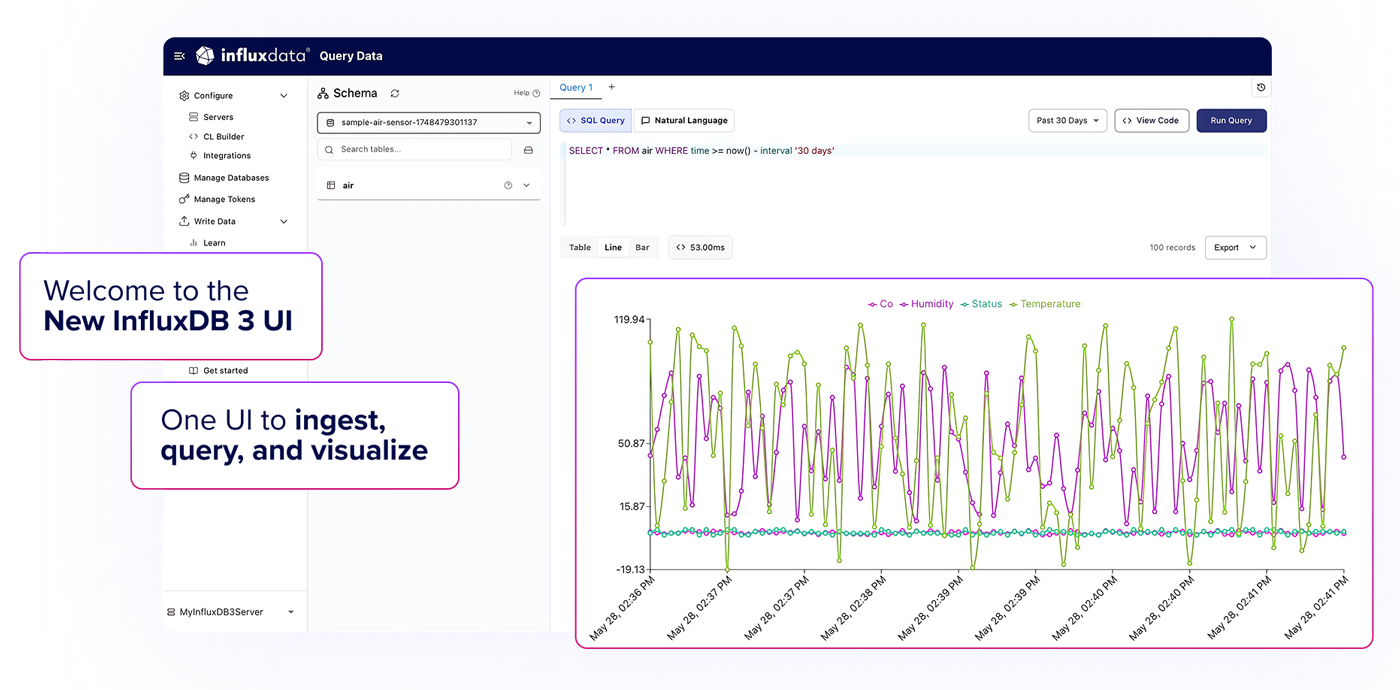Time series starts with InfluxDB open source.
InfluxDB 3 Core deploys in seconds.
High-Speed Recent-Data Queries
Query data in milliseconds
High-Performance Data Engine
Columnar engine for high-speed analytics, object storage, and real-time data insights
Open and Flexible Licensing
Built on MIT and Apache 2 for maximum freedom and collaboration
Deploy anywhere, at any scale
Any edge, on-prem, private cloud, or hybrid deployment. Or find the right cloud product.
InfluxDB 3 Core
Start in seconds with Core, an open source, recent data engine
Download
- Single-node time series data engine
- Optimized for real-time use cases
- Sub-10ms recent-data queries with last-value cache
- Processing Engine for real-time transformation and embedded intelligence
- Upgrade in seconds to InfluxDB 3 Enterprise for production workloads
Register Your Download
Get access to the latest product updates and guidance.
InfluxDB 3 Enterprise
Easily upgrade to Enterprise, a fast, scalable, and production-ready time series database that deploys anywhere
Download- Highly available for multi-node setups
- Built for any use case: real-time, AI/ML, and historical
- Sub-10ms recent-data queries with last-value cache
- Processing Engine for real-time transformation and embedded intelligence
- Read Replica support
- Enterprise security: SOC 2, ISO 27001, ISO 27018, GDPR ready
- End-to-end encryption
InfluxDB 3 Explorer
The fastest way to learn, run, & explore
Explorer is the built-in UI for InfluxDB 3, combining tools for onboarding, ingestion, data management, query building, and visualization, so you can go from setup to insight in minutes
Try InfluxDB
High-Speed Ingest
Ingest billions of series with fewer CPUs and less RAM
Real-Time Querying
Sub-10 millisecond query responses for live and recent data
Unlimited Cardinality
Ingest, transform, and query unlimited time series with unmatched speed and flexibility
Low-Cost Object Storage
Parquet files store more data with less space
Seamless Integration
Integrate with the tools you love via Python-based plugin systems
Native SQL
Analyze data using simple SQL or InfluxQL, a SQL-like language for time series data
Built-in intelligence with the InfluxDB 3 Processing Engine
Run custom Python directly in InfluxDB 3. Turn your database into an active intelligence layer, transforming, enriching, and responding to streaming data in real-time—without external services or pipelines.
Learn More
Built to adapt. Designed to scale.
InfluxDB 3 Core runs on a diskless, cloud-native architecture for maximum flexibility and simplicity.
Download NowEasy to operate
No cluster coordination, no rebalancing. Just start a node and go—less to manage, faster to scale.
Run your way
Deploy diskless with object storage (S3, GCS, Azure Blob). Stateless, portable, and built to run anywhere.
Fast from the start
Built-in caching serves hot data directly from memory for real-time queries without ever touching the object store.
Open data standards drive performance and interoperability
InfluxDB 3 is built in Rust and the FDAP stack—Flight, DataFusion, Arrow, and Parquet—leveraging Apache-backed technologies to efficiently ingest, store, and analyze time series data at any scale.
Try InfluxDBF
Flight for efficient columnar data transfer

D
DataFusion for high-performance querying
A
Arrow for optimized in-memory columnar analytics

P
Parquet for high-compression storage
The Spirit of Open Source
Join the community
Start building today

< GETTING STARTED >
GA Launch: InfluxDB 3 Core and InfluxDB 3 Enterprise
Start fast, scale faster. Now generally available, take a tour and install InfluxDB 3 Core or InfluxDB 3 Enterprise in seconds.
Learn MoreInfluxDB 3 Core
Easily install for Linux, Mac, RHEL, Docker:
curl -O https://www.influxdata.com/d/install_influxdb3.sh && sh install_influxdb3.sh
Or install on Windows and more
Register your download for access to the new InfluxDB Open Source Software Onboarding Guide, and product updates.
Trial for Free
Start free with self-managed, our most popular setup.
Easily install for Linux, Mac, RHEL, Docker:
curl -O https://www.influxdata.com/d/install_influxdb3.sh && sh install_influxdb3.sh enterprise
For Windows installation, see the Getting Started Guide.
By default, trials are 30 days. Need more time? We can help extend it. Contact Us.




